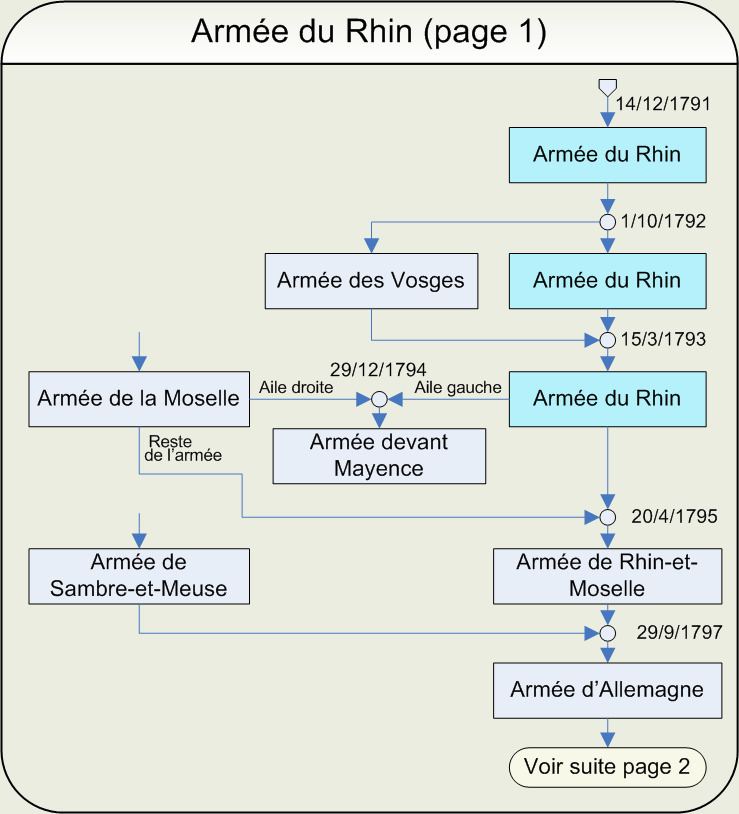Allegiance First Republic Founded 1791 | Disbanded 20 April 1795 | |
 | ||
Active 1791–95, 1797–98, 1799–1801 March Chant de guerre pour l'Armée du Rhin Notable commanders Nicolas Luckner, Adam Philippe, Comte de Custine Similar Army of Italy, Army of the Danube, Grande Armée, French Revolutionary Army, National Guard | ||
The Army of the Rhine (Armée du Rhin) was formed in December 1791, for the purpose of bringing the French Revolution to the German states along the Rhine River. During its first year in action (1792), under command of Adam Philippe Custine, the Army of the Rhine participated in several victories, including Mainz, Frankfurt and Speyer. Subsequently, the army underwent several reorganizations and merged with the Army of the Moselle to form the Army of the Rhine and Moselle on 20 April 1795.
Contents
Revolutionary Wars
The Army of the Rhine (Armée du Rhin) was one of the main French Revolutionary armies operated in the Rhineland theater, principally in the Rhine River valley, from 1791 to 1795. At its creation, the Army of the Rhine had 88,390 men. It was formed on 14 December 1791, to defend France's eastern frontier in conjunction with two other armies, the Army of the North and the Army of the Center (name changed in October 1792 to Army of the Moselle). These armies were subdivided, fresh forces were raised and gradually grew until, by 30 April 1793, eleven armies encircled France on its coastal and the land frontiers. In October 1792, a portion of the army was used to form the Army of the Vosges but these units rejoined the Army of the Rhine on 15 March 1793.
Song of Glory
In the first months of fighting, victories for France were few. Although Custine had succeeded in driving the ecclesiastical authorities from the Swiss village of Porrentruy by 27 April 1792, this singular victory was accomplished largely through the enterprises of a local uprising assisted by some advanced guard and it was the last French victory for several weeks: subsequently, the borders of France had been assaulted by the Habsburgs and their allies. At Mons (18–29 April 1792), Tournay (29 April 1792), Bavay (17 May 1792), Rumégies (19 May 1792), Florennes 28 May 1792, and La Glisuelle, a village 5 kilometers (3 mi) north of Maubeuge (11 June 1792), Austrian skirmishers repeatedly defeated French forces.
Although much of the spring and summer of 1792 action continued throughout in the border regions with Belgium, the cities along the Upper Rhine, especially the city of Strasbourg, felt under threat of invasion by the Habsburg armies massing on the east side of the Rhine River. On 25 April 1792, Philippe Friedrich Dietrich, mayor of Strasbourg, asked a guest, Claude Joseph Rouget de Lisle, to compose a song to rally against the Habsburg threat. That evening, Rouget de Lisle wrote "Chant de guerre pour l'Armée du Rhin" (English: "War Song for the Army of the Rhine"), and dedicated the song to Marshal Nicolas Luckner, a Bavarian in French service. The melody soon became the rallying call to the Revolution: Allons enfants de la Patrie (Arise, children of the Fatherland)/Le jour de gloire est arrivé! (The day of glory has arrived!). It was renamed "La Marseillaise".
Successes under Custine's command
The French government ordered Luckner to take command of the Army of the North, and Custine replaced him as overall commander of the Army of the Rhine in Spring 1793. Under his experienced command, the Army took several important positions on the Rhine, including at Speyer, Mainz, Limburg and Frankfurt (see chart of battles below).
Final reorganization
On 29 December 1794, the left wing of the Army and the right wing of the Army of the Moselle combined to form the Army besieging Mainz. The rest of the Army of the Moselle united with the Army of the Rhine on 20 April, to form the Army of the Rhine and Moselle. This army united with the Army of Sambre-et-Meuse to form the Army of Germany on 29 September 1797.
1793 Order of Battle
In its five-year history, the Army had several Orders of Battle. This is the OOB at the beginning of the 1793 campaign.
Commanders
Stability of command of the Army of the Rhine reflected the overall chaos of the French Revolutionary governments, especially in the years 1791–1794. Four of the generals serving in those years were guillotined (see chart below).
Other incarnations
An army of the Bourbon Restoration bore this name. In 1815 during the Hundred Days the V Corps – Armée du Rhin under the command of General Jean Rapp, was cantoned near Strassburg, and fought holding actions against contingents of Russians and Austrians, the largest of which was the Battle of La Suffel on fought on 28 June 1815.
This name was also used for the French military forces posted to Germany during the Occupation of the Rhineland (1919–1930), following the First World War.
Related people
People known to have served in this Armée include:
